No CrossRef data available.
Article contents
Development of alexia in real time from disruption of the vertical occipital fasciculus during awake brain surgery: A case study
Published online by Cambridge University Press: 05 November 2025
Abstract
Reading is a complex cognitive process requiring the integration of orthographic, phonological, and semantic information. The visual word form area, located in the ventral occipitotemporal cortex, is critically involved in orthographic decoding, and damage to this region is known to cause alexia. In contrast, the contributions of white matter pathways supporting reading are less well understood.
We present a unique neurosurgical case undergoing awake brain surgery for resection of a metastasis in the left occipitotemporal cortex. A tubular retractor was used to access the lesion and during the insertion of the retractor the patient underwent careful, continuous neuropsychological testing, including evaluation of reading. fMRI language mapping and diffusion MRI were performed preoperatively. Postoperative neuropsychological testing was completed two weeks after surgery to assess cognitive outcome.
The patient developed an alexia with letter-by-letter reading in real time during insertion of the tubular retractor. Stealth imaging enabled localization of the tubular retractor at the exact onset of the alexia and, by correlating this with tractography, showed that the tubular retractor was in the vertical occipital fasciculus (VOF).
We present the first detailed case report linking the VOF to the acute onset of alexia observed intraoperatively during awake brain surgery. We discuss the connectomics of reading and possible contributions of the VOF in reading.
Information
- Type
- Case Report
- Information
- Copyright
- © The Author(s), 2025. Published by Cambridge University Press on behalf of International Neuropsychological Society

